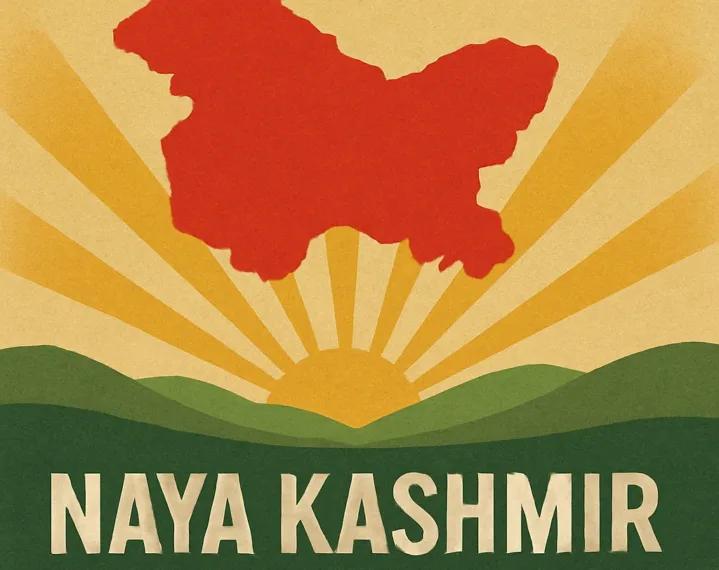The idea of Naya Kashmir originally emerged in 1944 as a progressive socio-economic charter aimed at establishing a democratic and egalitarian society in Kashmir. It is both a privilege and a responsibility to pen down a topic that holds deep significance for every Indian. Jammu and Kashmir, nestled in the majestic Himalayas, has long been known for its breathtaking beauty, rich culture and resilient people. Yet, for last three decades, it has also carried the burden of Pak prong terrorism. But today, we stand at a crucial juncture where hope, development, and stability are beginning to replace fear and stagnation. “Naya Kashmir”, the new Kashmir is not just a phrase, it is a vision rooted in comprehensive development, peace and opportunity for all. It is the promise of a region that no longer lives under the shadow of its past, but shines with the possibilities of its future.
Following the constitutional changes enacted in August 2019, the Union Territory of Jammu and Kashmir has undergone a broad transformation aimed at fostering good governance, enhancing infrastructure, empowering youth and integrating the region more closely with India’s national development trajectory and has become a case study in conflict-sensitive development, digital innovation and institution building.
At the heart of the new vision lies institutional reform. A suite of e-Governance initiatives ranging from digitised land records (Apni Zameen Apni Nigrani), to real-time public grievance redressal systems has significantly improved transparency and accountability. These tools aim to bridge the gap between the state and its citizens, promote participatory governance. Decentralised governance has been strengthened through the empowerment of Panchayati Raj Institutions (village-level councils), allowing for grassroots planning and local decision-making a marked shift from decades of centralized administration.
Massive infrastructure development is a cornerstone of Naya Kashmir. Key projects such as the world’s highest railway bridge over the Chenab River and the all-weather Zojila Tunnel connecting Kashmir with Ladakh are redefining physical connectivity in the Himalayan region. Investments in smart city infrastructure in Srinagar and Jammu aim to modernise urban governance and improve quality of life.
To catalyse economic growth, the region has adopted a forward-looking industrial policy. With a focus on sectors like tourism, information technology, horticulture and handicrafts, Jammu and Kashmir is positioning itself as an investment-friendly destination. Financial incentives, streamlined regulatory mechanisms and a single-window clearance system are designed to attract both domestic and international investors. Special attention is being given to traditional industries such as Pashmina weaving and papier-mâché craft through Geographical Indication (GI) certification and global marketing platforms. Women’s empowerment is gaining momentum through self-help groups, financial literacy programs and leadership development initiatives, marking a shift toward greater gender inclusion. With over 60% of its population under the age of 35, Kashmir’s youth are central to its transformation. Investments in sports infrastructure, talent promotion through national-level competitions like Khelo India and job creation schemes are fostering aspiration and engagement.
Simultaneously, cultural revival efforts including film shoots, literary festivals and heritage conservation are enabling the region to reclaim its soft power and global cultural footprint. Stability is essential to any sustainable development model. A significant decline in violence, coupled with community-based peacebuilding programs, is laying the groundwork for long-term security. Reintegration initiatives, vocational training for reformed youth and strengthened law enforcement frameworks are contributing to a more peaceful social fabric.
While progress is evident, Naya Kashmir faces complex challenges like ecological fragility, equitable political representation and the need for sustained economic opportunity. Dialogue, institutional capacity-building and environmental sustainability will be key to ensuring that development is inclusive and durable. The International community has a role to play whether through investment partnerships, cultural exchanges, or multilateral support for education, climate resilience and heritage conservation.
Naya Kashmir offers a compelling example of how post-conflict regions can be guided toward peace and prosperity through integrated development, digital transformation and citizen empowerment. As the region moves forward, the real measure of success will lie not only in metrics of Gross Domestic Product or infrastructure but in the dignity, voice and agency afforded to every Kashmiri citizen. In this vision, Naya Kashmir is not merely a domestic aspiration, it is a model of regional renewal with global relevance.


